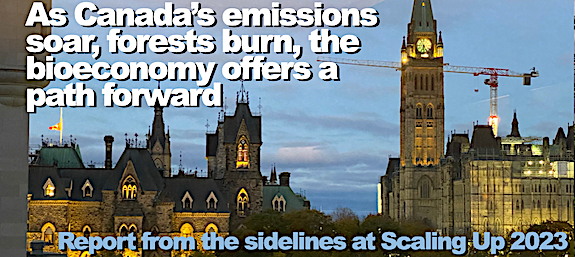16 Tons and What do You Get: Canada grapples with bioeconomy growth as forests burn, emissions soar

OTTAWA — “The Inflation Reduction Act changed everything” is the headline comment as Canada’s leading bioeconomy event, Jeff Passmore’s Scaling Up 2023 got underway in its traditional home at Ottawa’s Chateau Laurier, but nothing else was traditional as speakers grappled with spiraling Canadian emissions, the unique demand in cold Canada for heat as well as power, and continuing controversy about how to sustainably manage Canada’s forest resources.
It’s always a pleasure to visit Canada, home to vast infrastructure and raw materials and a nation that appears to be populated entirely of polite people, and Jeff Passmore puts on the classiest event in the bioeconomy, right down to the Gordon Webster jazz trio at breakfast each day — but it’s his power as the prime convener of Canada’s bioeconomy thought leaders that’s the heart of Scaling Up — it would be better if Canada had a bioeconomy event called Scaled Up, but it remains a work in progress.
10 takeaways from Ottawa this year
1. Interest is rampant in the US Inflation Reduction Act, for which the final rules are expected as soon as December and as late as March 2024. The huge volume in tax credits, which will require production in the United States although the energy produced can be exported anywhere, has frozen Canadian development and finance as financiers await a full understanding of where best to locate future projects. There could be a small boom on the south side but close to the US border, where projects can take advantage of Canadian feedstock and end-user markets but US manufacturing to take advantage of US tax credits.
2. There was quite a lot of attention paid to the potential of carbon capture and sequestration to dramatically lower emissions and the carbon intensity, for example, of fossil or renewable fuels. In Digestville, we’re not enthusiastic about technologies that gasify biomass to capture hydrogen or. sequester the carbon emissions. The technology will definitely work — there’s nothing impossible about creating syngas from biomass, or separating hydrogen from carbon monoxide. We worry that for every ton of hydrogen you need at least 16 tons of biomass, and you end up with 25 tons or so of CO2, more or less. If you can acquire the biomass at the US Billion Ton Study target price of $60 per ton and a sequestration cost of $100 per ton, the economics get very challenged very quickly, unless there are lavish and extensive carbon credits, forever. We continue to believe that the better use for syngas is to make highs-value, higher-utilization rate products. As the old song put it, “16 tons and what do you get? A little bit older and deeper in debt.”
3. Discussion continues on the stick versus carrot approach. The US focused on incentives and innovation, the EU focused on penalties and regulations. The mood leans towards penalties and regulations — there was an appetite for expanded mandates, production tax credits that bridge the gap between bioeconomy production costs and market prices, and more support from the public sector for funding the development capital gap between bench and commercial scale.
4. Canadians continue to focus very much on policymakers. Jeff Passmore put up a slide highlighting the (increasing) number and distribution of provinces and federal government officials at Scaling Up. Heard on the Floor, a less use of the word “finance” and more references to “funding” than you hear at US-based events.
5. It wouldn’t be a Canadian conference without reference to diversifying the Alberta economy and reducing dependence on export of oil and gas to generate dollars for Canada’s balance of trade. Sigh.
6. More pushback on electric vehicles than we’ve heard of late. US analyst Tammy Klein speculated that “some of the EV hype may be fading with more recognition that a portfolio approach to energy will dominate for some time to come, despite a hard push from NGOs for the “electrify everything” approach. As the zen master says, we’ll see, and the enthusiasm for IC engines north of the border may have something to do with Canada’s massive exports in oil & gas. But any views that contribute to the emerging consensus on energy diversity are good ones.
7. A discussion on the impact and stability of Canada’s new Clean Fuel Regulations tended to pooh-pooh suggestions that a Conservative government in the future would scrap the CFR, but did note that one of the reasons for the CFR’s potential survival is because it’s lower thresholds and longer timelines than, for example, the British Columbia Low Carbon Fuel Standard, makes it less impactful on the prices Canadians are paying at the pump, compared to the impact of a direct carbon tax.
8. A shift has been noted in the focus on advanced Canadian R&D towards food ingredients and advanced materials.
9. Recognition that there’s not enough emphasis on valorizing the forest assets of Canada. Jaime Stephen of TorchLight Biosciences presented a fascinating comparison of the emissions and forest management approach of Sweden and Canada — both forest-dominated countries but with wildly different practices and results.
10. Bottom line. Record breaking wildfires in Canada. The burn this year was 25 times the annual Canadian harvest – smoke as far south as California and Florida. It’s clear a new direction is needed, new urgency is required. Perhaps the best way to think of it is this: Scandinavian forest practices + Canadian biomass and technology + US financial engineering = success.
Category: Top Stories















